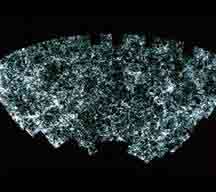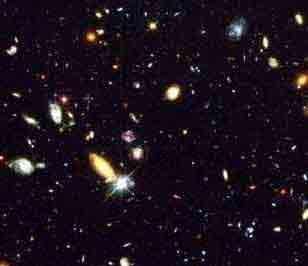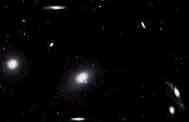|
     
>
History
>
Life Cycle of Galaxy
> Types of Galaxies
> Distribution of
Galaxies
> Milky Way Galaxy
> Andromeda
Galaxy
      
|
Galaxies are
generally not isolated in space but are usually members of small or
moderate-sized groups, which in turn form large clusters and superclusters
of galaxies. Our galaxy is one of a small group of about 40 galaxies that
astronomers call the Local Group. The Milky Way and the
Andromeda Galaxy
are the two largest members, each with 100 to 200 billion stars. The Large
and Small Magellanic Clouds are nearby satellite galaxies, but each is
small and faint, with about 100 million stars.

|
Distribution of the Galaxies
This optical map, covering about 4,300 square
degrees, or 10 per cent of the sky, shows the distribution in space
of some 2 million galaxies. Galaxies tend to clump together—in this
image, black represents areas of empty space and blue represents the
galaxies. The image suggests that galaxies dot the surfaces of giant
interconnected bubbles surrounding immense voids of empty space.
|
The nearest cluster of galaxies is the Virgo cluster; the Local Group
is an outlying member of the cluster, which contains thousands of galaxies
of many types. They all share a common direction of motion, the cause of
which might be a supercluster hidden from view by our own galaxy, since
superclusters up to 300 million light years across are known.
 |
Hubble Deep Field
In December 1995 astronomers were
able to prove that there are five times more galaxies in the
universe than previously thought. Helping them in this conclusion
was a composite image of photographs taken from the orbiting
Hubble
Space Telescope. Covering a tiny speck of the sky, the image, known
as the Hubble Deep Field, depicts galaxies as faint as magnitude 30
(about 4 billion times fainter than can be seen with the naked eye).
Formed some 12 billion years ago, they were the the most distant
galaxies ever seen. |
Overall, the distribution of clusters and superclusters of galaxies in
the universe is not uniform. Instead, superclusters of tens of thousands
of galaxies are arranged in long, stringy, lace-like filaments, arranged
around large voids. The Great Wall, a galactic filament discovered in
1989, stretches across more than half a billion light years of space.
Cosmologists conjecture that dark matter may exist in sufficient
quantities to generate the gravitational fields responsible for the
heterogeneous structure of the universe. In 1998 astronomers using the
ROSAT orbiting X-ray observatory announced that the pattern of heat
distribution in clouds of gas surrounding galaxy clusters demonstrated
that the galaxies themselves must have formed before they began grouping
into clusters and larger structures.
 |
Virgo Cluster of Galaxies
The Virgo Cluster is a
gravitationally bound group of galaxies lying some 50 million light
years from us. It is the nearest galaxy cluster to the Local Group
of galaxies in which our own Milky Way is situated, and it is moving
away from the Local Group at several hundred kilometers per second.
The two largest galaxies in this image of the centre of the cluster
are the bright ellipticals M84, left, and M86, centre. |
The most distant galaxies yet observed are those in the image known as the
Hubble Deep Field, obtained with the Hubble Space Telescope in December
1995, and a follow-up image of a portion of the same area of sky imaged in
the infrared in October 1998. The Deep Field contains galaxies as faint as
magnitude 30 (some 4 billion times fainter than can be seen with the naked
eye), which are estimated to have been formed about 12 billion years ago,
when the universe was only about 5 per cent of its present age.
Extrapolated to the whole sky, the image implies a five-fold increase in
the number of galaxies over previous estimates. The infrared image in 1998
was able to capture even fainter, cooler galaxies. The target location, in
the constellation Ursa Major, was chosen because it contained no major
foreground objects that would obscure the view of distant galaxies.
[Back] [Top] [Next] |


